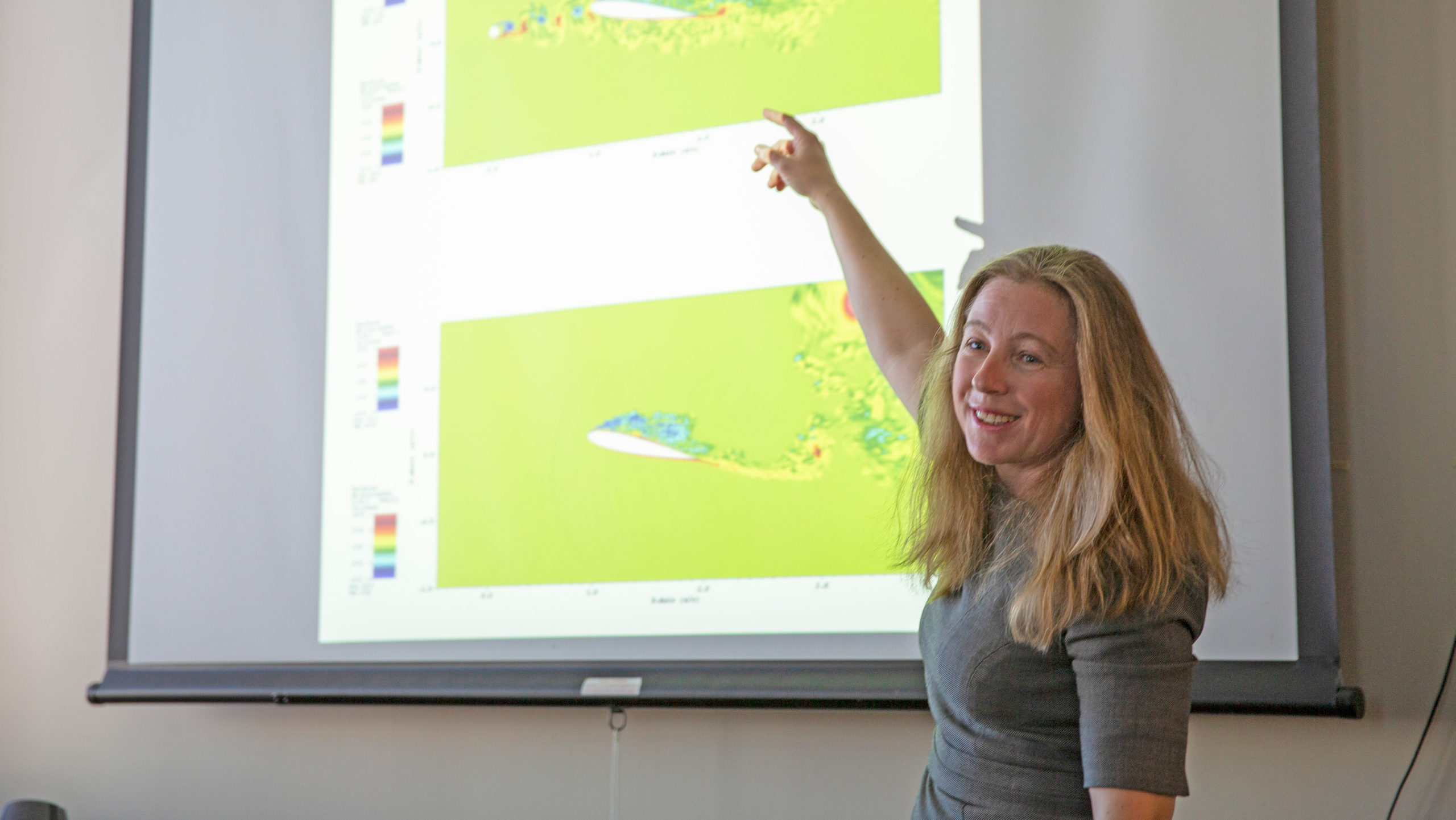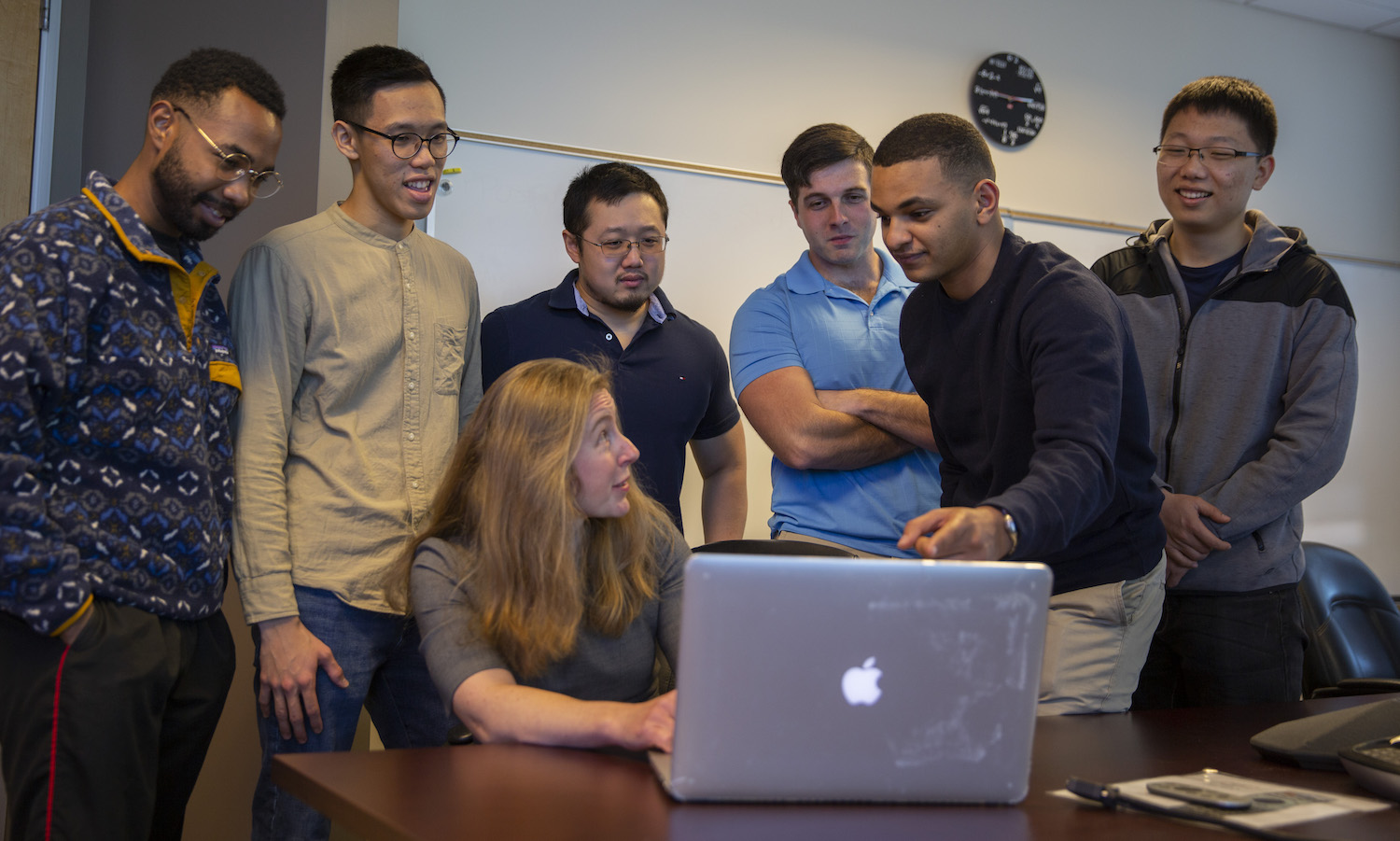
Harnessing forces of turbulent flow key to array of tech solutions

Above: Yulia Peet, an assistant professor of aerospace and mechanical engineering in the Ira A. Fulton Schools of Engineering , shows students screen images simulating turbulent flow around a pitching airfoil — a section of an airplane wing that is moving up and down. Study of such movement is important to ensure the maneuverability of aircraft and in applications of rotary technologies, such as those used for helicopters and wind turbines, in which blades rotate in and out of wind direction. Simulations like these are a key tool in the research Peet will do with funding from a National Science Foundation CAREER Award to advance knowledge about fluid dynamics and turbulence. The visualizations are based on simulations created by Fulton Schools alumnus Brandon Merrill, who earned a doctoral degree in aerospace engineering under Peet’s guidance. Photographer: Connor McKee/ ASU
Twelve faculty members in the Ira A. Fulton Schools of Engineering at Arizona State University received NSF CAREER Awards between November 2019 and April 2020.
Exceedingly intricate physical forces underlie the flow of fluids — specifically liquids and gases, including air. Important leaps forward in multiple areas of engineering and science are possible if fluid dynamics become fully understood and controlled.
Advances could be achieved in the performance of aircraft, engines, energy production systems, biomedical devices and more, says Yulia Peet, an assistant professor of aerospace and mechanical engineering in the Ira A. Fulton Schools of Engineering at Arizona State University.
The research Peet will lead with support from a National Science Foundation Faculty Early Career Development Program (CAREER) Award aims to provide more of the theoretical groundwork needed to spark those innovations.
Combining her skills in high-performance computing — particularly computational fluid dynamics — and expertise in fluid mechanics and turbulent flows, Peet is prepared to develop and test new or expanded theories in those areas.
Peet and the research team in her Integrative Simulations and Computational Fluids Lab will search for more complete answers to big questions about fluid flows that are in a state of turbulence — which means the fluid particles move randomly and undergo constant changes in velocity, magnitude and direction.
The project will focus on investigating the mechanisms of fluid-structure interaction — interaction between deformable surfaces (airplane wings, heat exchanger rods, parachute structures, piezoelectric energy harvesters, for example) and fluid turbulence.
Turbulence, in general, is the chaotic motion of fluid particles in a flow. There’s also a phenomenon called near-wall turbulence, which grows from the instability created in a layer of fluid particles close to a wall.
“Basically, the wall retards the fluid layer right above the wall and acts to create vortices in that layer, which promotes the generation of turbulence,” Peet says.
All of that happens when a wall is rigid. But if the wall becomes flexible, it can deform under the influence of fluid forces.
“So, the important question is, ‘What happens to the turbulence then?’” Peet says.
Her objective is to develop new theories to explain how such interactions — like those that occur when a wall is deformable — change the structure of turbulent flow.
“We want to better understand how turbulence evolves, how it sustains itself and how it degenerates, and how fluid-structure interaction effects add a new dimension to this body of knowledge, which is yet to be uncovered,” says Peet, who teaches in the School for Engineering of Matter, Transport and Energy, one of the six Fulton Schools.
“We want to find mechanisms for suppressing and sometimes strengthening the forces of turbulence and look at what kinds of flexible wall motions you need to create to change and control those forces,” she says. “Then you can manipulate turbulence for whatever purposes you want.”

Assistant Professor Yulia Peet looks at computational visualizations of a turbulent fluid flow with students in the Ira A. Fulton Schools of Engineering who work in her Integrated Simulations and Computational Fluids Lab. Standing, from left to right, are undergraduates Hezekiah Grayer and Jen Ping Chu and doctoral students YiQin Xu, Daniel Coxe, Ahmed Abouhussein and Fengrui Zhang. Photographer: Connor McKee/ ASU
Applications in aviation, health care, energy and security
Learning how to control turbulent flow could reduce atmospheric resistance, or “drag,” on aircraft in flight and thus enable better fuel efficiency. Flow control can also improve the aerodynamic stability of aircraft, including unmanned aerial vehicles, commonly called drones.
Decreasing flow resistance due to turbulence can help in building ships and underwater robots that will be able to move faster and be more maneuverable.
Being able to alter the structure of turbulence can also help maximize the flow of liquids through pipelines, increase blood flow through implanted medical devices, like stents, and help to make medications work more effectively.
Enhancing or restraining turbulence can improve the performance of systems that rely on heat transfer, including internal combustion and turbine engines, manufacturing operations and technologies that harness thermal energy for refrigeration, insulation and overall energy conservation.
Peet also will study the fluid-structure interactions created by what are called compliant coatings, which are composed of soft materials applied to solid structures, such as the hulls of ships. The coatings help to make the ships more resistant to decay triggered by environmental factors, including the destructive impacts of microorganisms that tend to cling to the hulls.
Compliant coatings also reduce the “acoustic signature” of a ship. The signature is the flow-induced noise made by a ship in motion. Reducing that noise is critical for the security of ships — especially military vessels — enabling them to avoid being located by detection systems.
Such coatings are able to deform under the influence of flows and also interact with those flows. Peet wants to apply new knowledge about the physics of turbulence to discover ways to organize the coupled motions of a flexible wall and a flow “so that they can affect things in positive ways,” she says.
“These have been very difficult challenges for many years, but now we have advanced computational tools,” Peet says. “So, I think we can answer questions that have not been answered before and contribute to solutions in many technical areas.”
Developing the toolset needed to gain valuable insights
The NSF CAREER Award provides $500,000 over five years to help Peet and her team make that progress.
The awards recognize university faculty who have been effective in integrating research and education into their work, and who are seen as future leaders in both research and education in their fields.
Peet has already made notable contributions to computational fluid dynamics, says Xiaohua Wu, a professor of mechanical engineering at the Royal Military College of Canada, who met Peet when they worked at the Center for Turbulence Research at Stanford University.
“The coupled aero-elasticity and turbulence problem she is going to tackle in her NSF CAREER Award project requires exactly the type of highly accurate and energy-conserving computational toolset her group at ASU has been developing,” Wu says. “The insights to be extracted from this project can be used to improve existing reduced-order models and substantially reduce the design turnaround time for aerospace engineers doing computational fluid dynamics.”
Another longtime colleague, Leonardo P. Chamorro, an associate professor in the Department of Mechanical Science and Engineering at the University of Illinois at Urbana-Champaign, says he looks forward to seeing Peet’s “well deserved“ NSF award enabling her “to advance the field of flow-structure interaction significantly, and tackle very challenging engineering problems ranging from locomotion to energy.”
To meet the educational objectives of her CAREER Award project, Peet will seek to increase the attraction and retention of females and other underrepresented groups in the engineering professions.
Focusing on introducing these concepts to elementary and middle school children, Peet and her team will develop interactive fluid-flow visualizations for internet and iPhone applications, using simple demonstrations of fluid-structure interactions that are common in everyday life.



































